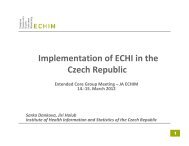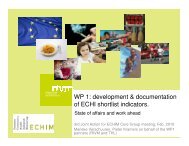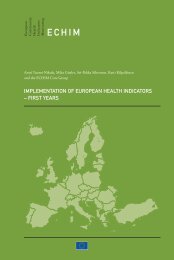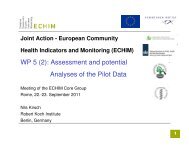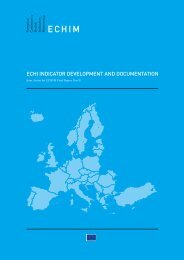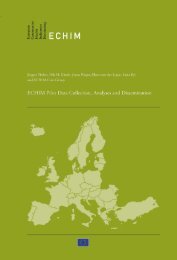INDICATORS
ECHIM Final Report
ECHIM Final Report
You also want an ePaper? Increase the reach of your titles
YUMPU automatically turns print PDFs into web optimized ePapers that Google loves.
Notes:<br />
1) Incidence refers to person’s first stroke event. Ideally the denominator should be those<br />
who have not had a stroke before, but in practice this is not possible. The total population<br />
in the denominator gives a good approximation. Attack rate counts the first and recurrent<br />
events, whenever there is at least 28 days between the onset of the events. Incidence is more<br />
interesting than attack rate, although both yield very similar information. Data for the attack<br />
rate are more widely available. Distinction between a first stroke event and a recurrent one<br />
is practically impossible in many countries without intelligent follow-up and data linkage<br />
across several years of hospital discharge records. Only local registers with active follow-up<br />
can capture those stroke attacks that never reach the hospital (estimated between 5% and<br />
10% by the US Burden of Disease). Routine data linkage of hospital and mortality data is<br />
not possible in many countries because of privacy rules and data protection legislation.<br />
2) Here and for the incidence/attack rate the age range is limited because the disease is rare<br />
in younger people. On the other hand, co-morbidity in the older people would complicate<br />
the interpretation of the results if this were included. Ad hoc studies to validate of estimates<br />
of deaths due to stroke from routinely collected mortality data have shown that this source of<br />
information is of varying quality (from 70% to 90% are confirmed by registers).<br />
3) Respondents reporting past stroke ever (EHIS question HS.5). Interview surveys are an<br />
inaccurate source of information, here because self-report data tend to involve substantial<br />
misreporting.<br />
26. ASTHMA<br />
Definition: Prevalence of persons with asthma in the population, with specification for children.<br />
Calculation:<br />
1) Proportion of individuals reporting to have been diagnosed with asthma which occurred<br />
during the past 12 months, per 100 000 survey population, derived from EHIS questions<br />
HS.4/5/6: HS.4: Do you have or have you ever had any of the following diseases or<br />
conditions? 1. Asthma (allergic asthma included) (yes / no). If yes: HS.5: Was this disease/<br />
condition diagnosed by a medical doctor? (yes / no). HS.6: Have you had this disease/<br />
condition in the past 12 months? (yes / no).<br />
2) Number of hospital discharges for asthma in a year, per 100 000 population<br />
3) Number of asthma-diagnosed patients in primary care, in a given year, per 100 000 survey<br />
population<br />
4) Number of persons complying to specified asthma symptoms, per 100 000 survey<br />
population, in special surveys.<br />
5) Number of children with asthma, per 100 000 of the respective age group.<br />
Notes: ECHIM preference is as follows: Professionally, 4 gives the best estimate of<br />
population prevalence, followed by 3. In practice, 1 and 2 will be the only sources available<br />
in most countries. 2 will give an underestimate of population prevalence since many asthma<br />
patients will never be hospitalised. ICD-10 category: J45. IMCA proposes to include also<br />
asthma severity.<br />
99




